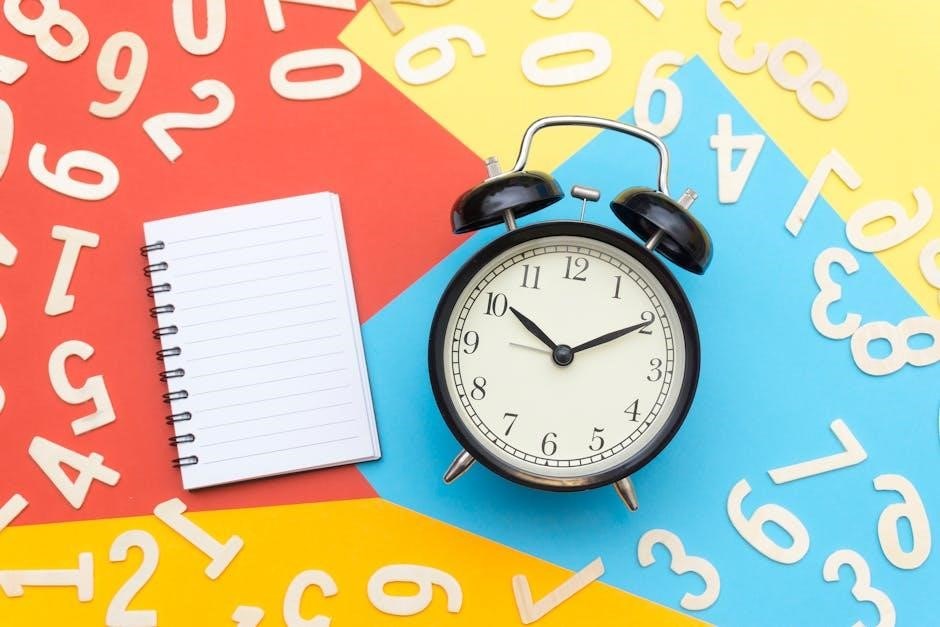
spanish alphabet pdf
Embark on your Spanish learning journey by exploring el alfabeto! Understanding the Spanish alphabet is fundamental for pronunciation and comprehension. It’s a crucial first step towards fluency, opening doors to rich culture.
Importance of Mastering the Spanish Alphabet
Mastering the Spanish alphabet is paramount for accurate pronunciation and spelling, foundational skills for effective communication. Correctly pronouncing words builds confidence and ensures you’re understood. Similarly, proper spelling enhances written communication.
A solid grasp of el alfabeto enables accurate reading comprehension of Spanish texts. Recognising letters and their sounds allows you to decode words and understand meaning. Knowing the alphabet helps you use dictionaries and other learning resources.
Furthermore, understanding the Spanish alphabet facilitates vocabulary acquisition. Recognizing letter patterns and word structures aids in memorization. Mastering the alphabet allows you to learn Spanish efficiently and confidently, making communication easier and more enjoyable. It’s your gateway to fluency!
The 27 Letters of the Spanish Alphabet
The Spanish alphabet comprises 27 letters, including the distinctive “Ñ”. Understanding each letter is crucial. Knowing their names is essential for spelling and dictionary use, marking the start of fluency.
Listing all 27 Letters (A to Z)
The Spanish alphabet, also known as el abecedario, includes 27 letters. Here’s a comprehensive list to guide your learning:
- A (a)
- B (be)
- C (ce)
- D (de)
- E (e)
- F (efe)
- G (ge)
- H (hache)
- I (i)
- J (jota)
- K (ka)
- L (ele)
- M (eme)
- N (ene)
- Ñ (eñe)
- O (o)
- P (pe)
- Q (cu)
- R (ere)
- S (ese)
- T (te)
- U (u)
- V (uve)
- W (uve doble)
- X (equis)
- Y (ye or i griega)
- Z (zeta)
Mastering this list is the first step towards reading and writing in Spanish. Remember to practice the pronunciation of each letter for better comprehension. This foundation is vital for language learning.
The Letter “Ñ”
The letter “Ñ” (eñe) is a unique and essential part of the Spanish alphabet, setting it apart from English. It represents a distinct sound, a palatal nasal, similar to the “ny” in “canyon.” This letter is not merely an “N” with a tilde; it’s a completely separate character with its own pronunciation and place in the alphabet, following “N.”
Words containing “Ñ” are common in Spanish, such as España (Spain), mañana (tomorrow), and niño (child). Understanding and pronouncing “Ñ” correctly is crucial for accurate pronunciation and comprehension. Failing to do so can change the meaning of words significantly. Practice the sound and incorporate it into your vocabulary to enhance your Spanish skills. This letter adds a unique flavor to the Spanish language.

Pronunciation Guide for Each Letter
Mastering Spanish pronunciation requires understanding each letter’s sound. This guide provides clear explanations and examples to help you articulate each letter accurately. Consistent practice will refine your accent.
Vowel Pronunciation in Spanish
Spanish vowels, unlike their English counterparts, maintain relatively consistent sounds. The five vowels are: A, E, I, O, and U. “A” is pronounced like “ah” in “father.” “E” resembles the “eh” sound in “bed.” “I” is pronounced like “ee” in “see.” “O” sounds like “oh” in “go,” and “U” is pronounced like “oo” in “moon.”
These consistent vowel sounds make Spanish pronunciation more predictable. Mastering these sounds early on is crucial for accurate pronunciation. Remember that the Spanish alphabet has twenty-seven letters (five vowels and twenty-two consonants). Practice each vowel sound individually and within words to solidify your understanding; Pay attention to how vowels combine to form diphthongs, as these combinations have unique pronunciations.
Consistent practice is the key to mastering these sounds. Access free resources like SpanishPod101 lessons to further enhance your pronunciation skills.
Consonant Pronunciation Differences from English
Several Spanish consonants differ significantly in pronunciation from English. The letter “H” is silent in Spanish. “J” is pronounced like a strong “H” sound, similar to the Scottish “loch.” “V” and “B” are pronounced almost identically, usually as a “B” sound. “C” has two pronunciations: like “K” before “a,” “o,” and “u,” but like “th” in Spain or “s” in Latin America before “e” and “i.”
The letter “Z” is pronounced similarly to the “C” before “e” and “i.” “R” is trilled, especially at the beginning of words. “Ñ” is a unique letter pronounced like “ny” in “canyon.” Mastering these differences is crucial for clear communication. Remember to practice these sounds and refer to pronunciation guides. Utilizing resources from Spanish learning platforms can greatly aid in pronunciation.
Pay close attention to regional variations in pronunciation, as these can also affect consonant sounds.

Digraphs in Spanish (Ch, Ll, and Rr)
Spanish features digraphs: ch, ll, and rr. These are two-letter combinations representing single sounds. Mastering their pronunciation is key to fluency. They are essential components of Spanish vocabulary and grammar, impacting meaning.
Pronunciation of “Ch”
The digraph “ch” in Spanish represents a sound similar to the “ch” in the English word “church.” It’s a voiceless postalveolar affricate, meaning it involves a combination of a stop and a fricative sound produced slightly behind the alveolar ridge (the ridge behind your teeth). Unlike English, where “ch” can sometimes sound like a “k” (as in “chaos”), the Spanish “ch” consistently maintains its distinct “church” sound.
To pronounce it correctly, start by positioning your tongue as if you were going to say “t,” but slightly further back in your mouth. Then, instead of releasing the air abruptly like a “t,” release it gradually, creating a friction sound. This combination of the stop and the friction results in the characteristic “ch” sound in words like “chocolate” (chocolate) and “muchacho” (boy).
Pay attention to native speakers and practice repeating words with “ch” to refine your pronunciation.
Pronunciation of “Ll”
The digraph “ll” in Spanish presents a fascinating case of regional variation. Traditionally, it represented a palatal lateral approximant, similar to the “lli” in the English word “million.” However, in many parts of the Spanish-speaking world, particularly in Latin America, it’s pronounced like the “y” in “yellow.” This phenomenon is called yeísmo.
In regions where the traditional pronunciation is maintained, the “ll” sound is produced by placing the tongue against the roof of the mouth, allowing air to flow along the sides. This creates a distinct “lli” sound. However, in yeísta regions, the “ll” and “y” sounds have merged, making them indistinguishable.
When learning Spanish, it’s helpful to be aware of both pronunciations. While the “y” sound is widely accepted and understood, recognizing the traditional “lli” sound can enhance your comprehension, especially when listening to speakers from Spain or certain areas of Latin America.
Pronunciation of “Rr”
The “rr” in Spanish, known as the rolled or trilled “r,” is a sound that often challenges English speakers. Unlike the single “r,” the “rr” requires a vibration of the tongue against the roof of the mouth. Mastering this sound is crucial for accurate pronunciation and avoiding miscommunication.
To produce the “rr” sound, place the tip of your tongue near the alveolar ridge (the area behind your upper teeth). Then, exhale and try to make your tongue vibrate rapidly. It might take practice to achieve the correct coordination and muscle control. Some find it helpful to imagine saying a quick series of “d” sounds.
The “rr” sound appears at the beginning of words (e.g., rojo ⎼ red) and when the letter “r” is doubled (e.g., perro ⎼ dog). It’s a stronger, more emphasized sound than the single “r,” which also has its own distinct pronunciation in Spanish. Consistent practice and listening to native speakers are key to mastering this iconic Spanish sound.

Free Printable Spanish Alphabet Charts
Unlock your Spanish learning with free printable alphabet charts! These visual aids offer a quick reference for letter recognition and pronunciation. Download, print, and start mastering el alfabeto today!
Benefits of Using Charts for Learning
Spanish alphabet charts offer numerous benefits for learners of all ages. These visual aids provide a structured and easily accessible reference point for mastering the letters and their corresponding pronunciations. Charts are particularly useful for beginners as they clearly present the entire alphabet in one place, aiding memorization and recall.
Moreover, charts often include helpful information such as letter names, example words, and pronunciation guides. This multi-sensory approach enhances learning and retention. The visual format of a chart allows learners to quickly identify and review letters, reinforcing their understanding of the Spanish alphabet. They are also effective tools for classroom settings, enabling teachers to present and reinforce the alphabet in an engaging manner. Furthermore, learners can use these charts for self-study. Consistent practice and exposure to the alphabet through charts can significantly improve a learner’s overall proficiency.
Where to Find Free Printable Charts (PDF format)
Finding free, printable Spanish alphabet charts in PDF format is easier than ever, thanks to numerous online resources. Many educational websites, language learning platforms, and blogs offer these charts as free downloads. Look for reputable sites specializing in Spanish language resources. These sites often provide high-quality charts with clear layouts and accurate information.
A simple online search for “free Spanish alphabet chart PDF” will yield a plethora of options. Before downloading, ensure the chart is well-designed, easy to read, and includes pronunciation guidance. Some websites may require a free account registration before allowing downloads. Others offer direct downloads without any signup. Be cautious of sites that seem suspicious or request excessive personal information. Printable charts can be found on sites offering learning materials.

Spanish Alphabet Worksheets for Practice
Reinforce your Spanish alphabet knowledge with targeted worksheets. These resources offer practical exercises in handwriting and vocabulary building. They provide valuable opportunities for effective learning and skill development.
Handwriting Practice Worksheets
Improve your Spanish handwriting with dedicated practice worksheets! These resources are essential for mastering the formation of each letter in el alfabeto. Consistent practice builds muscle memory, leading to clearer and more legible handwriting. Many free printable worksheets focus on tracing letters, both uppercase and lowercase, aiding beginners in developing proper stroke order and letter shape.
Worksheets often include dotted lines to guide your hand, gradually transitioning to independent writing. Repetition is key; consistent use of these worksheets will solidify your handwriting skills. Practicing with various fonts can further enhance your ability to recognize and reproduce the letters. Don’t underestimate the importance of handwriting practice; it’s a vital step in Spanish language mastery.
Worksheets are readily available online, offering a convenient and accessible way to improve your penmanship.
Vocabulary Building with Alphabet Worksheets
Enhance your Spanish vocabulary alongside your alphabet skills using targeted worksheets. These worksheets connect each letter with relevant Spanish words, facilitating both letter recognition and vocabulary acquisition. By associating letters with corresponding words, you strengthen memory and understanding. Many worksheets incorporate images alongside the words, providing visual cues for enhanced learning.
These worksheets commonly feature exercises like matching letters to words, filling in missing letters, and writing out entire words. Such activities reinforce both spelling and vocabulary. Focus on worksheets tailored to your learning level, gradually increasing difficulty as your skills improve.
Regular use of vocabulary-focused alphabet worksheets will expand your Spanish lexicon and improve your overall language proficiency. Incorporate these worksheets into your study routine for a fun and effective learning experience. Remember, building a strong vocabulary is crucial for fluent communication in Spanish. Worksheets often include themes to further engage the learner.
Related Posts

carrier comfortlink alarm codes pdf
Download the comprehensive Carrier ComfortLink alarm codes PDF guide for easy troubleshooting and system maintenance. Get instant access now!
squallywood pdf
Download Squallywood PDF instantly. Get your free copy now!

gottman worksheets for couples pdf
Strengthen your relationship with free Gottman worksheets for couples. Download printable PDFs based on research-backed strategies to improve communication and connection.